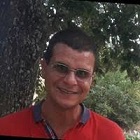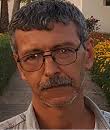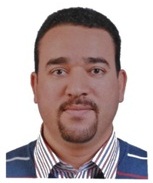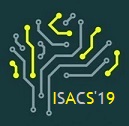The applicability of Information Centric Network to the Internet of Things
Prof. AMINE DHRAIEF, Higher School Of Digital Economy, University of Manouba, Tunisia.
|

|
Prof. Amine Dhraief received his PhD in Computer Science from Télécom Bretagne in 2009, Master of Science degree and Engineering degree both in Computer Science from the National School of Computer Sciences (ENSI), the University of Manouba respectively. in 2006 and 2005. He is currently an Assistant Professor of Computer Science at Higher School Of Digital Economy, University of Manouba, Tunisia. His research and teaching interests focus on computer networks and distributed systems. He is currently serving on several reputed international conference Technical Program Committees. He organized and served as the technical Committee Chair and the organizing committee chair of many international conferences. He lead several national and international research project. He has been involved in several national and international collaborative research projects. His current research interests include future Internet architectures, performance evaluation and protocol optimization and specification. He is the author of more than 50 articles and papers in refereed journals and international conferences.
|
Hermitian codes and restricted Hermitian codes: their parameters, automorphisms, implementations and applications in the McEliece cryptosystem
Prof. Gábor P. Nagy, Budapest University of Technology , Hungary.
For safe and secure communication and data storage, we must be able to correct errors which are caused either by some random noise or by pollution attacks of an adversary. The largest class of error correcting codes with good parameters and an effective decoding algorithm is formed by the algebraic geometric (AG) codes. This class contains the Reed-Solomon codes and many generalizations of them. The construction of an AG code is based on an algebraic curve X over a finite field GF(q). The investigations require methods from the theory of function fields, finite geometry and group theory. In our research we focus on Hermitian curves, which are the best known class of nontrivial maximal curves. In my talk, I will present some recent results on bounds of the minimum distance of Hermitian curves; here the main tool is the understanding of the structure of the Weierstrass semigroup at higher degree places and divisors. I will make special focus on the software implementation techniques of the computation of the generator matrix of Hermitian codes and of the decoding algorithm. In the second part of the talk, I will deal with subfield subcodes of Hermitian codes. Here, the main question is if we can produce binary codes for the McEliece Cryptosystem with better parameters than the binary Goppa codes.
|

|
Prof. Gábor P. Nagy, received the degree of doctor of Sciences in 2015 et the Hungarian Academy of Sciences. In 2013, he received the Habilitation from the University of Szeged (Hungary). He also received the PhD in Mathematics in 2000 et the University of Erlangen (Germany) and in 1999 at the University of Szeged. He is currently professor at Budapest University of Technology since 2016. He is a public member of the Hungarian Academy of Sciences and an editor of Journal of Geometry and Acta Math Szeged. He received several prizes and scholarships. His research field includes algebra, finite geometry and discrete mathematics, and all domains which are related to cryptography and the theory of error correcting codes.
|
A Survey of 3D Reconstruction
Prof. Khalid SATORI, Sidi Mohamed Ben Abdellah University, Fez - Morocco
3D reconstruction from images is an important and widely studied axis in recent decades. Its importance is reflected in the diversity of its application fields, namely: robotics, quality control, surveillance, medicine, shape recognition, augmented reality, video games, and others. There are several approaches of three-dimensional perception of the environment, however, the main approaches used are: reconstruction from silhouettes, reconstruction from texture, reconstruction from camera movement and reconstruction from epipolar geometry:
Reconstruction from Silhouettes: Used in multi-camera environments, called "Shape from Silhouette", it makes an all-encompassing estimate of the 3D shape and visual envelope of interest objects. Usually two types to distinguished, surface and volume in real time.
The reconstruction from texture: called "Shape from texture". Approaches of this type estimate the shape of objects from observed variations in texture. However, objects that will be rebuilt must be textured.
The reconstruction from camera movement: called "Shape from motion", allows recovering the three-dimensional structure from a displacement vector field, indicating the projection of an object or scene in motion, in image planes.
Reconstruction from epipolar geometry: called "Shape from epipolar geometry", the methods of this category are the most used in the field of computer vision. The main difficulty of these techniques results from the problem of the matching of the points between image couples. But once the matching is discerned for each couple of points from the two ordinary views, these points can be triangulated to estimate the 3D points of the homologous scene.
 |
Prof. Khalid Satori received the PhD degree from the National Institute for the Applied Sciences INSA at Lyon in 1993. He received the Thesis of doctorate of State in Science at Faculty of Sciences of Fez in 1999. He is currently a professor of higher education of computer science at USMBA-Fez University. He is the director of the LIIAN Laboratory and the Head of Department of Computer Science at the Faculty of Science of Fez. His research interests include real-time rendering, Image-based rendering, virtual reality, biomedical signal, camera self calibration and 3D reconstruction.
|
Introduction to Security Proofs in Cryptography
Prof. Hussain Ben-azza, ENSAM, University of Moulay Ismail, Meknes, Morocco.
|

|
Prof. Hussain Ben-azza is a professor at ENSAM-National High School of Arts and Trades, Meknes, Morocco, attached to Department of Industrial and Production Engineering, Moulay Ismail University. He obtained his Ph.D. degree in mathematics and computer science in 1995 from Claude Bernard University Lyon 1, France. His research interests include coding theory, cryptography, wireless communications, but also applications of optimization techniques to industrial engineering.
|
Quasi-periodicity, chaos and coexistence in the time delay controlled two-cell DC-DC buck converter
Prof. Moez Feki, University of Sousse, Tunisia
Power converter interface devices are important for using energy storage systems (ESSs) in microgrids. With the development of power electronics technology, many different power converters have emerged. DC-DC converters have been used long before their behavior is completely understood. Indeed, it's only on late eighties that the existence of chaotic behavior in power converters has been reported. In this work, we present a modeling method and a thorough analysis of different scenarios leading to bifurcation and chaos. We show that the time delay controlled two-cell DC/DC buck converter, in addition to border collision bifurcation, may also exhibit a Neimark-Sacker bifurcation which for some parameter set may lead to a 2D Torus that may then break yielding a chaotic behavior. Besides, the saturation of the controller can also lead to the coexistence of a stable focus and a chaotic attractor. The results are presented using numerical simulation of a discrete map of the two-cell DC/DC buck converter obtained by expressing successive crossings of Poincaré section in terms of each other.
|

|
Prof. Moez Feki received his Bachelor's degree and Master's degree both in Electrical and Electronics Engineering from Bilkent University, Turkey in 1995 and 1997. Next, he obtained a PhD degree in Applied Mathematics from “Université de Metz” France in 2001. Until 2004 he was a post-doc student in the Electrical, Electronics and Automation department of Université de Reims Champagne-Ardenne, France. Currently, Moez Feki is a Professor at the University of Sousse Tunisia and is the vice chair of “Ecole Supérieure des Science et de la Technologie de Hammam-Sousse” and carrying his research activities in the “Laboratoire de Mathématiques Modélisation Déterministe et Aléatoire”. His research interests include non-linear control theory, with emphasis on analysis, control and synchronization of chaotic systems. Moez Feki is the author of 9 book chapters and more than 40 journal papers and 50 conference papers.
|







